Methods of Enquiry Essay: Finance Module Research Analysis - Autumn
VerifiedAdded on 2022/09/07
|13
|3113
|23
Essay
AI Summary
This essay critically analyzes the methods of enquiry used in two academic research papers related to finance. The first article, based on agency theory, explores how audit team time reporting is influenced by internal incentives and performance evaluations. The second paper investigates how external auditors communicate with audit committees, focusing on impression management within multiple accountability relationships. The essay examines the research questions, theoretical underpinnings, research methods, sample selection, validity, and data analysis techniques employed in each study. It compares the strengths and weaknesses of each approach and assesses the consistency of conclusions with findings. The analysis highlights the epistemological, ontological, and axiological differences between the research methods, providing insights into how these factors affect the scope and validity of the research, and the implications for future studies.
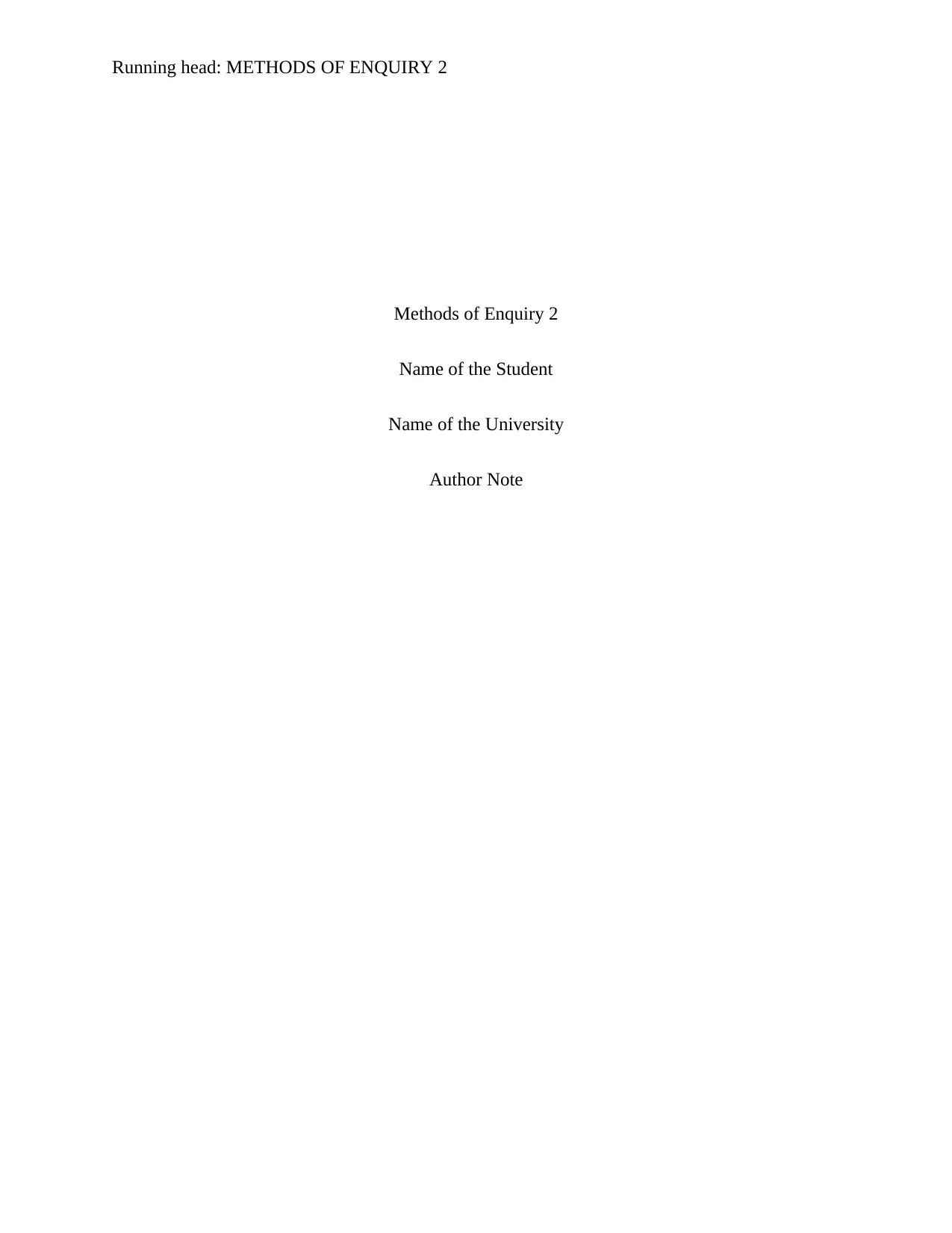
Running head: METHODS OF ENQUIRY 2
Methods of Enquiry 2
Name of the Student
Name of the University
Author Note
Methods of Enquiry 2
Name of the Student
Name of the University
Author Note
Paraphrase This Document
Need a fresh take? Get an instant paraphrase of this document with our AI Paraphraser
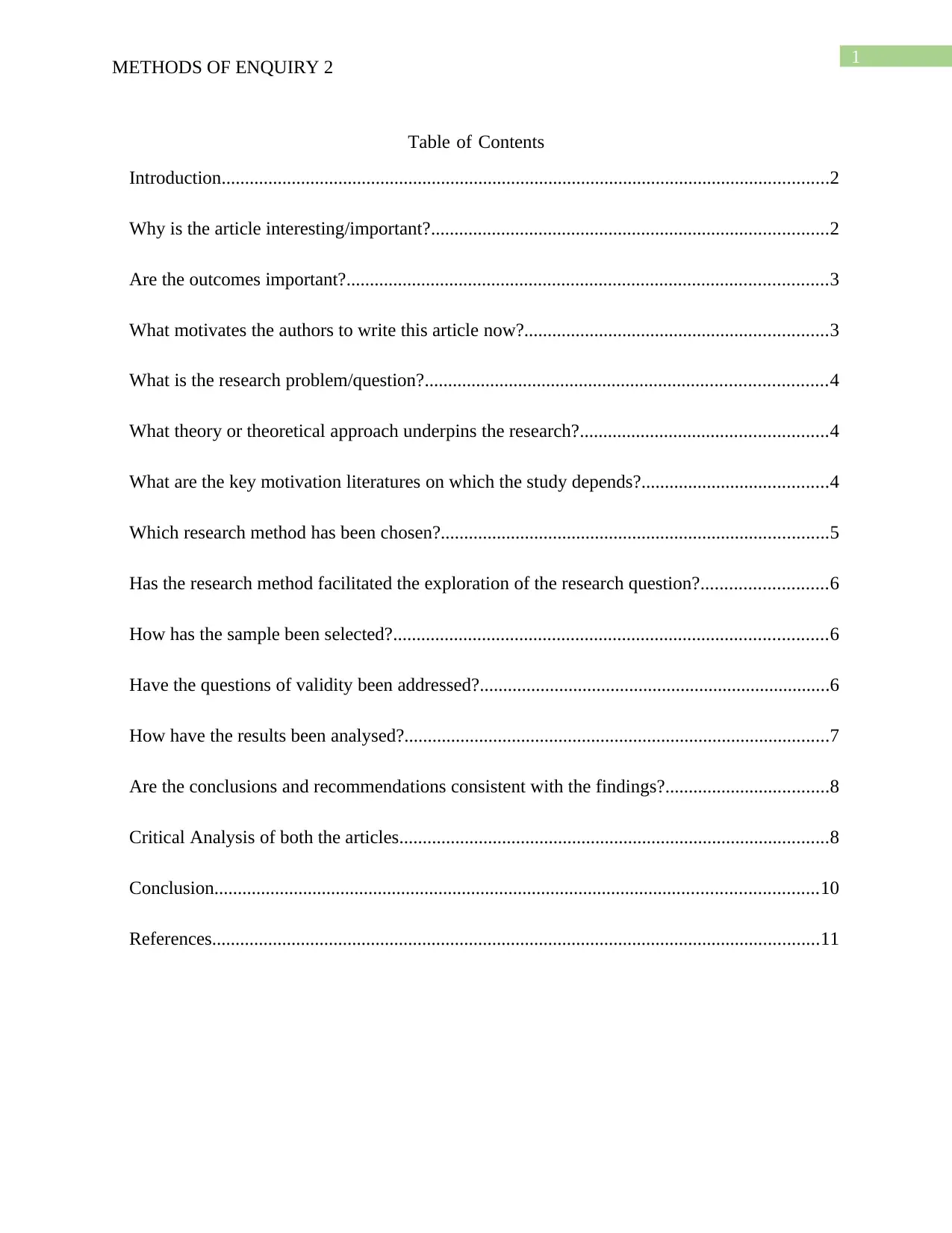
1
METHODS OF ENQUIRY 2
Table of Contents
Introduction..................................................................................................................................2
Why is the article interesting/important?.....................................................................................2
Are the outcomes important?.......................................................................................................3
What motivates the authors to write this article now?.................................................................3
What is the research problem/question?......................................................................................4
What theory or theoretical approach underpins the research?.....................................................4
What are the key motivation literatures on which the study depends?........................................4
Which research method has been chosen?...................................................................................5
Has the research method facilitated the exploration of the research question?...........................6
How has the sample been selected?.............................................................................................6
Have the questions of validity been addressed?...........................................................................6
How have the results been analysed?...........................................................................................7
Are the conclusions and recommendations consistent with the findings?...................................8
Critical Analysis of both the articles............................................................................................8
Conclusion.................................................................................................................................10
References..................................................................................................................................11
METHODS OF ENQUIRY 2
Table of Contents
Introduction..................................................................................................................................2
Why is the article interesting/important?.....................................................................................2
Are the outcomes important?.......................................................................................................3
What motivates the authors to write this article now?.................................................................3
What is the research problem/question?......................................................................................4
What theory or theoretical approach underpins the research?.....................................................4
What are the key motivation literatures on which the study depends?........................................4
Which research method has been chosen?...................................................................................5
Has the research method facilitated the exploration of the research question?...........................6
How has the sample been selected?.............................................................................................6
Have the questions of validity been addressed?...........................................................................6
How have the results been analysed?...........................................................................................7
Are the conclusions and recommendations consistent with the findings?...................................8
Critical Analysis of both the articles............................................................................................8
Conclusion.................................................................................................................................10
References..................................................................................................................................11

2
METHODS OF ENQUIRY 2
METHODS OF ENQUIRY 2
⊘ This is a preview!⊘
Do you want full access?
Subscribe today to unlock all pages.

Trusted by 1+ million students worldwide
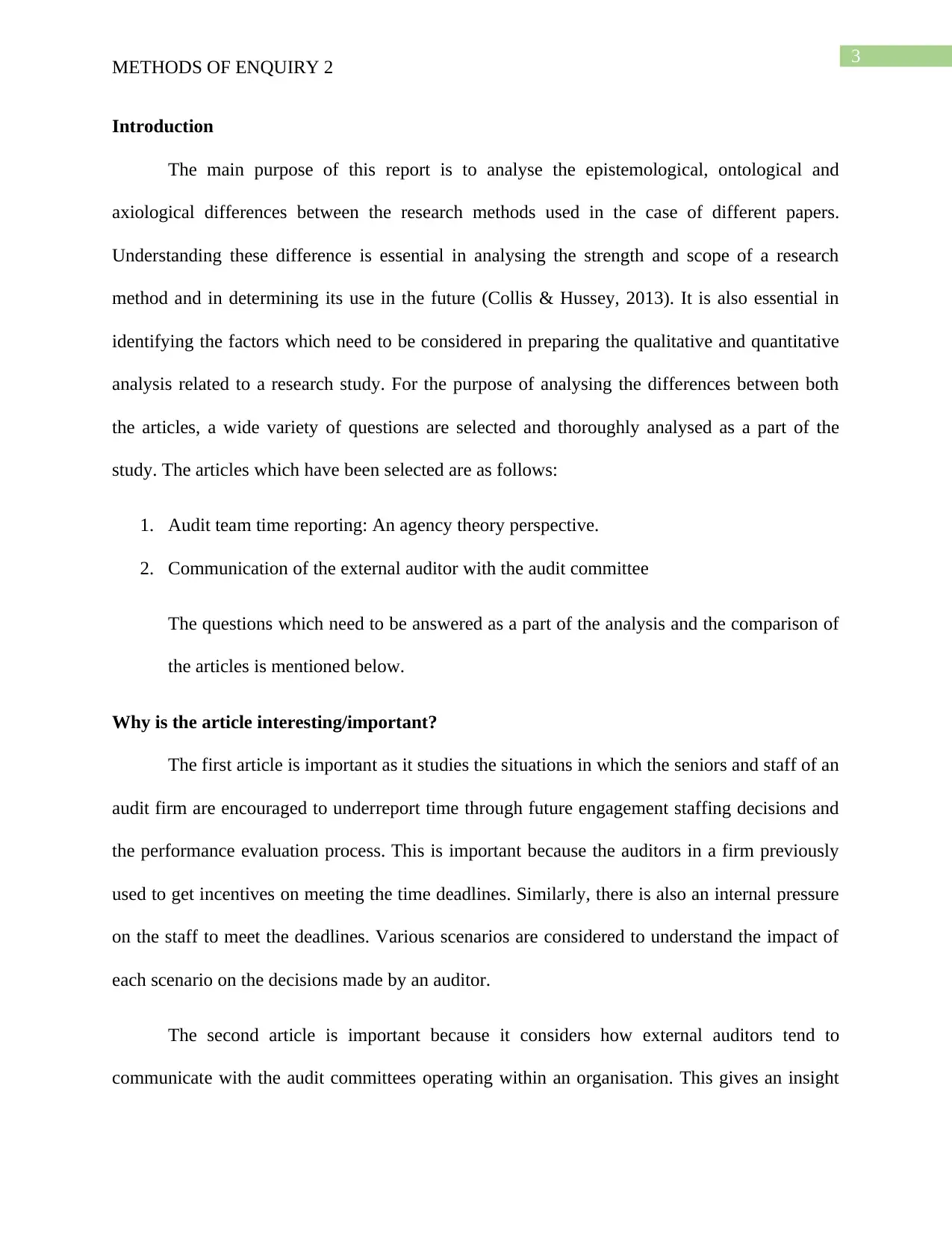
3
METHODS OF ENQUIRY 2
Introduction
The main purpose of this report is to analyse the epistemological, ontological and
axiological differences between the research methods used in the case of different papers.
Understanding these difference is essential in analysing the strength and scope of a research
method and in determining its use in the future (Collis & Hussey, 2013). It is also essential in
identifying the factors which need to be considered in preparing the qualitative and quantitative
analysis related to a research study. For the purpose of analysing the differences between both
the articles, a wide variety of questions are selected and thoroughly analysed as a part of the
study. The articles which have been selected are as follows:
1. Audit team time reporting: An agency theory perspective.
2. Communication of the external auditor with the audit committee
The questions which need to be answered as a part of the analysis and the comparison of
the articles is mentioned below.
Why is the article interesting/important?
The first article is important as it studies the situations in which the seniors and staff of an
audit firm are encouraged to underreport time through future engagement staffing decisions and
the performance evaluation process. This is important because the auditors in a firm previously
used to get incentives on meeting the time deadlines. Similarly, there is also an internal pressure
on the staff to meet the deadlines. Various scenarios are considered to understand the impact of
each scenario on the decisions made by an auditor.
The second article is important because it considers how external auditors tend to
communicate with the audit committees operating within an organisation. This gives an insight
METHODS OF ENQUIRY 2
Introduction
The main purpose of this report is to analyse the epistemological, ontological and
axiological differences between the research methods used in the case of different papers.
Understanding these difference is essential in analysing the strength and scope of a research
method and in determining its use in the future (Collis & Hussey, 2013). It is also essential in
identifying the factors which need to be considered in preparing the qualitative and quantitative
analysis related to a research study. For the purpose of analysing the differences between both
the articles, a wide variety of questions are selected and thoroughly analysed as a part of the
study. The articles which have been selected are as follows:
1. Audit team time reporting: An agency theory perspective.
2. Communication of the external auditor with the audit committee
The questions which need to be answered as a part of the analysis and the comparison of
the articles is mentioned below.
Why is the article interesting/important?
The first article is important as it studies the situations in which the seniors and staff of an
audit firm are encouraged to underreport time through future engagement staffing decisions and
the performance evaluation process. This is important because the auditors in a firm previously
used to get incentives on meeting the time deadlines. Similarly, there is also an internal pressure
on the staff to meet the deadlines. Various scenarios are considered to understand the impact of
each scenario on the decisions made by an auditor.
The second article is important because it considers how external auditors tend to
communicate with the audit committees operating within an organisation. This gives an insight
Paraphrase This Document
Need a fresh take? Get an instant paraphrase of this document with our AI Paraphraser
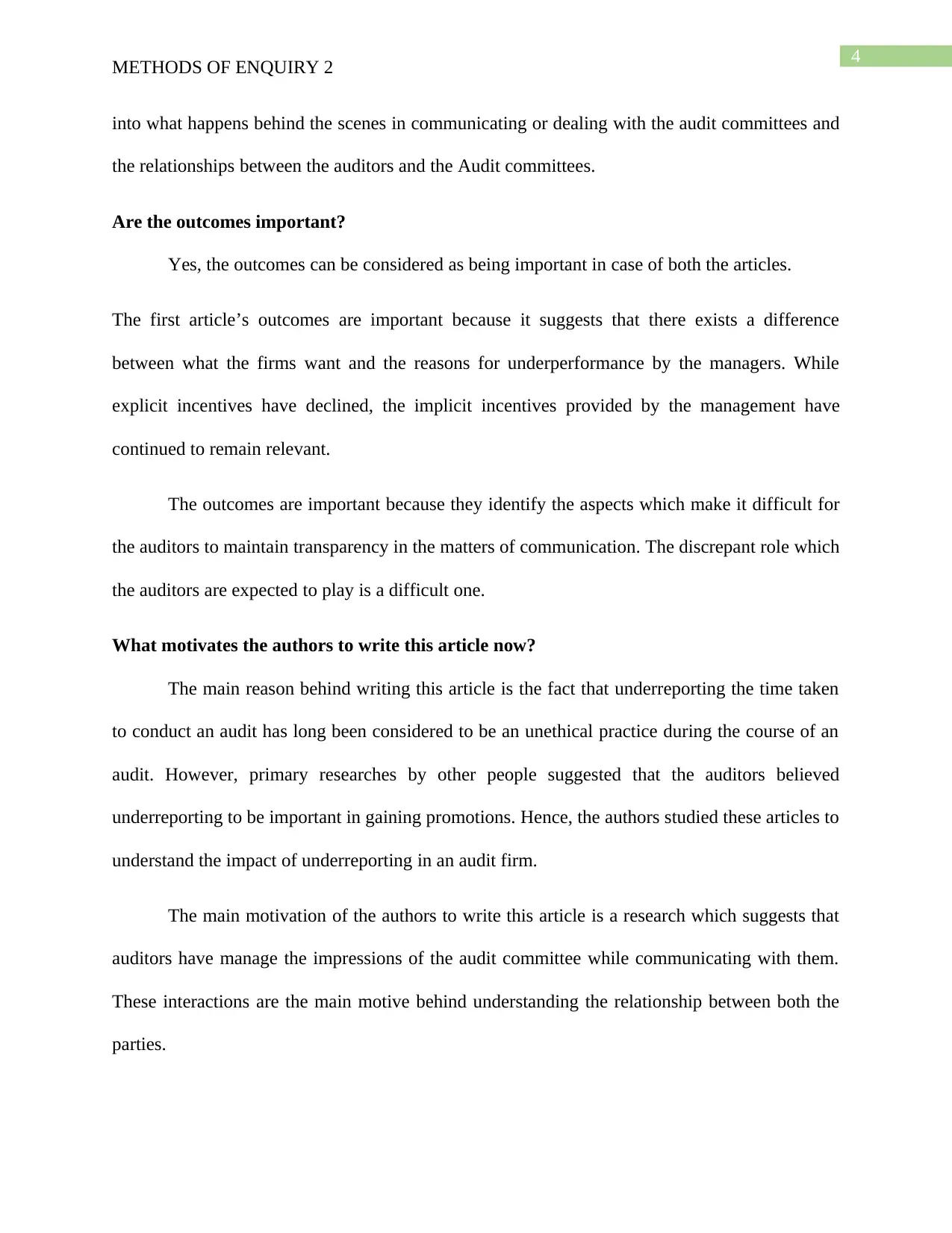
4
METHODS OF ENQUIRY 2
into what happens behind the scenes in communicating or dealing with the audit committees and
the relationships between the auditors and the Audit committees.
Are the outcomes important?
Yes, the outcomes can be considered as being important in case of both the articles.
The first article’s outcomes are important because it suggests that there exists a difference
between what the firms want and the reasons for underperformance by the managers. While
explicit incentives have declined, the implicit incentives provided by the management have
continued to remain relevant.
The outcomes are important because they identify the aspects which make it difficult for
the auditors to maintain transparency in the matters of communication. The discrepant role which
the auditors are expected to play is a difficult one.
What motivates the authors to write this article now?
The main reason behind writing this article is the fact that underreporting the time taken
to conduct an audit has long been considered to be an unethical practice during the course of an
audit. However, primary researches by other people suggested that the auditors believed
underreporting to be important in gaining promotions. Hence, the authors studied these articles to
understand the impact of underreporting in an audit firm.
The main motivation of the authors to write this article is a research which suggests that
auditors have manage the impressions of the audit committee while communicating with them.
These interactions are the main motive behind understanding the relationship between both the
parties.
METHODS OF ENQUIRY 2
into what happens behind the scenes in communicating or dealing with the audit committees and
the relationships between the auditors and the Audit committees.
Are the outcomes important?
Yes, the outcomes can be considered as being important in case of both the articles.
The first article’s outcomes are important because it suggests that there exists a difference
between what the firms want and the reasons for underperformance by the managers. While
explicit incentives have declined, the implicit incentives provided by the management have
continued to remain relevant.
The outcomes are important because they identify the aspects which make it difficult for
the auditors to maintain transparency in the matters of communication. The discrepant role which
the auditors are expected to play is a difficult one.
What motivates the authors to write this article now?
The main reason behind writing this article is the fact that underreporting the time taken
to conduct an audit has long been considered to be an unethical practice during the course of an
audit. However, primary researches by other people suggested that the auditors believed
underreporting to be important in gaining promotions. Hence, the authors studied these articles to
understand the impact of underreporting in an audit firm.
The main motivation of the authors to write this article is a research which suggests that
auditors have manage the impressions of the audit committee while communicating with them.
These interactions are the main motive behind understanding the relationship between both the
parties.
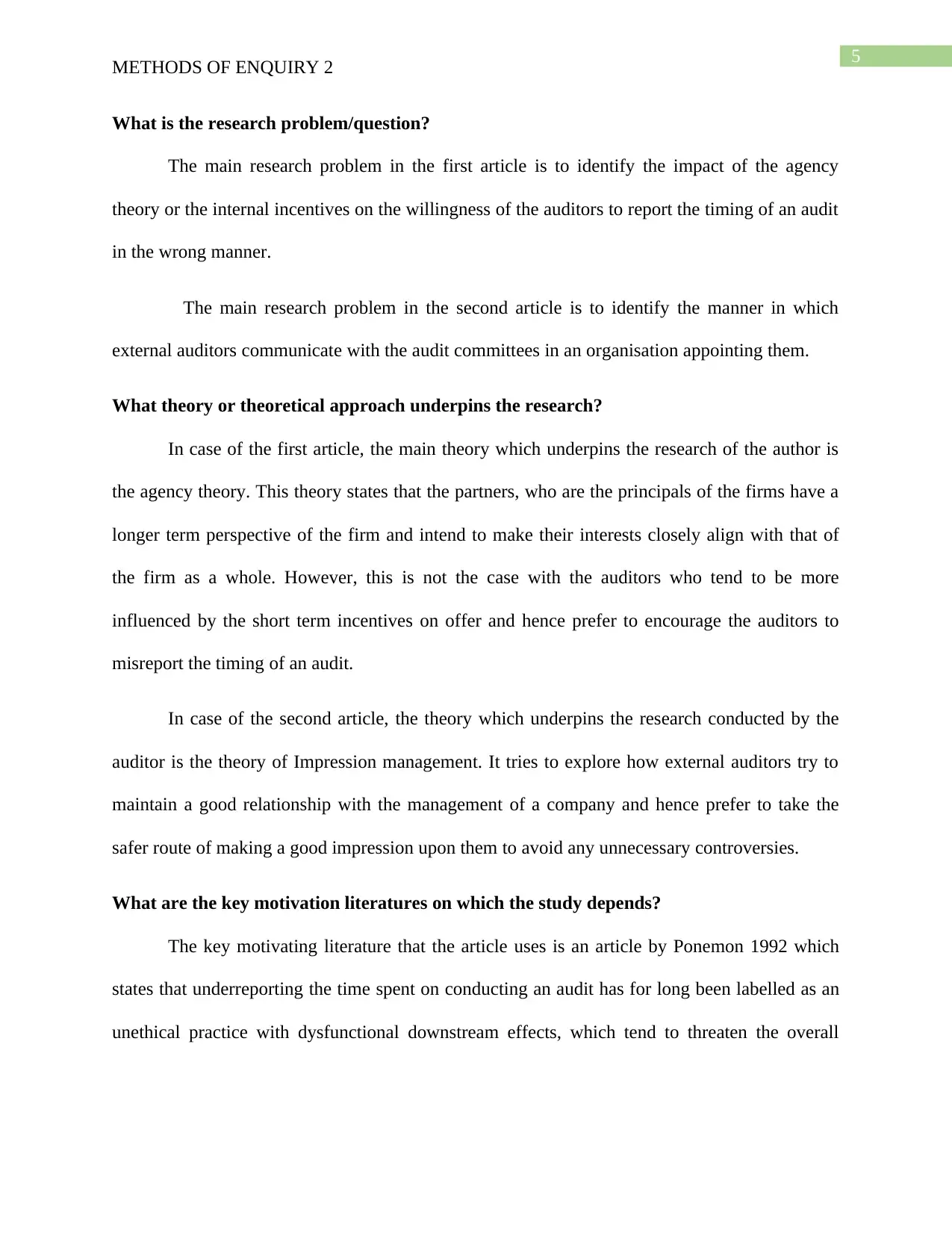
5
METHODS OF ENQUIRY 2
What is the research problem/question?
The main research problem in the first article is to identify the impact of the agency
theory or the internal incentives on the willingness of the auditors to report the timing of an audit
in the wrong manner.
The main research problem in the second article is to identify the manner in which
external auditors communicate with the audit committees in an organisation appointing them.
What theory or theoretical approach underpins the research?
In case of the first article, the main theory which underpins the research of the author is
the agency theory. This theory states that the partners, who are the principals of the firms have a
longer term perspective of the firm and intend to make their interests closely align with that of
the firm as a whole. However, this is not the case with the auditors who tend to be more
influenced by the short term incentives on offer and hence prefer to encourage the auditors to
misreport the timing of an audit.
In case of the second article, the theory which underpins the research conducted by the
auditor is the theory of Impression management. It tries to explore how external auditors try to
maintain a good relationship with the management of a company and hence prefer to take the
safer route of making a good impression upon them to avoid any unnecessary controversies.
What are the key motivation literatures on which the study depends?
The key motivating literature that the article uses is an article by Ponemon 1992 which
states that underreporting the time spent on conducting an audit has for long been labelled as an
unethical practice with dysfunctional downstream effects, which tend to threaten the overall
METHODS OF ENQUIRY 2
What is the research problem/question?
The main research problem in the first article is to identify the impact of the agency
theory or the internal incentives on the willingness of the auditors to report the timing of an audit
in the wrong manner.
The main research problem in the second article is to identify the manner in which
external auditors communicate with the audit committees in an organisation appointing them.
What theory or theoretical approach underpins the research?
In case of the first article, the main theory which underpins the research of the author is
the agency theory. This theory states that the partners, who are the principals of the firms have a
longer term perspective of the firm and intend to make their interests closely align with that of
the firm as a whole. However, this is not the case with the auditors who tend to be more
influenced by the short term incentives on offer and hence prefer to encourage the auditors to
misreport the timing of an audit.
In case of the second article, the theory which underpins the research conducted by the
auditor is the theory of Impression management. It tries to explore how external auditors try to
maintain a good relationship with the management of a company and hence prefer to take the
safer route of making a good impression upon them to avoid any unnecessary controversies.
What are the key motivation literatures on which the study depends?
The key motivating literature that the article uses is an article by Ponemon 1992 which
states that underreporting the time spent on conducting an audit has for long been labelled as an
unethical practice with dysfunctional downstream effects, which tend to threaten the overall
⊘ This is a preview!⊘
Do you want full access?
Subscribe today to unlock all pages.

Trusted by 1+ million students worldwide
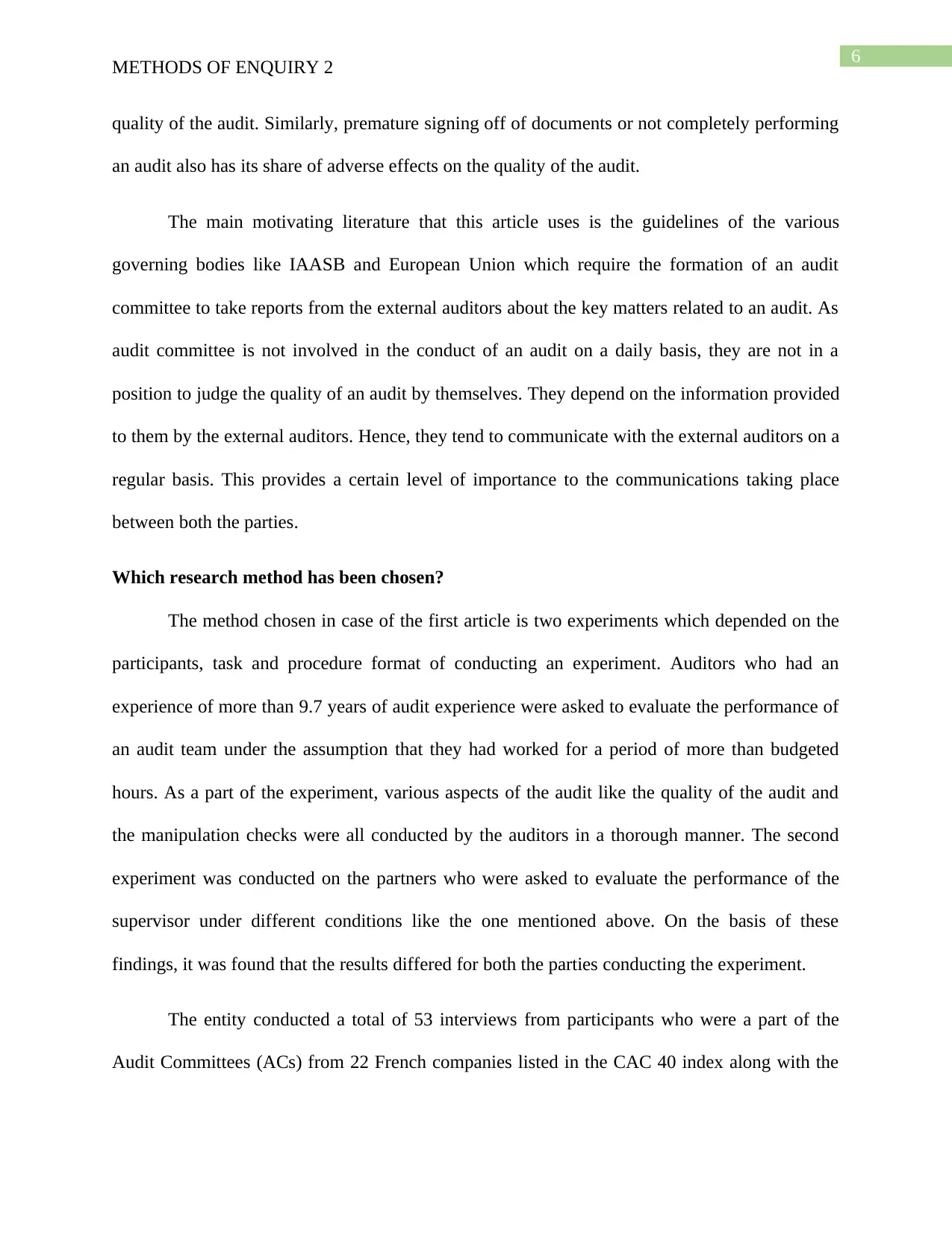
6
METHODS OF ENQUIRY 2
quality of the audit. Similarly, premature signing off of documents or not completely performing
an audit also has its share of adverse effects on the quality of the audit.
The main motivating literature that this article uses is the guidelines of the various
governing bodies like IAASB and European Union which require the formation of an audit
committee to take reports from the external auditors about the key matters related to an audit. As
audit committee is not involved in the conduct of an audit on a daily basis, they are not in a
position to judge the quality of an audit by themselves. They depend on the information provided
to them by the external auditors. Hence, they tend to communicate with the external auditors on a
regular basis. This provides a certain level of importance to the communications taking place
between both the parties.
Which research method has been chosen?
The method chosen in case of the first article is two experiments which depended on the
participants, task and procedure format of conducting an experiment. Auditors who had an
experience of more than 9.7 years of audit experience were asked to evaluate the performance of
an audit team under the assumption that they had worked for a period of more than budgeted
hours. As a part of the experiment, various aspects of the audit like the quality of the audit and
the manipulation checks were all conducted by the auditors in a thorough manner. The second
experiment was conducted on the partners who were asked to evaluate the performance of the
supervisor under different conditions like the one mentioned above. On the basis of these
findings, it was found that the results differed for both the parties conducting the experiment.
The entity conducted a total of 53 interviews from participants who were a part of the
Audit Committees (ACs) from 22 French companies listed in the CAC 40 index along with the
METHODS OF ENQUIRY 2
quality of the audit. Similarly, premature signing off of documents or not completely performing
an audit also has its share of adverse effects on the quality of the audit.
The main motivating literature that this article uses is the guidelines of the various
governing bodies like IAASB and European Union which require the formation of an audit
committee to take reports from the external auditors about the key matters related to an audit. As
audit committee is not involved in the conduct of an audit on a daily basis, they are not in a
position to judge the quality of an audit by themselves. They depend on the information provided
to them by the external auditors. Hence, they tend to communicate with the external auditors on a
regular basis. This provides a certain level of importance to the communications taking place
between both the parties.
Which research method has been chosen?
The method chosen in case of the first article is two experiments which depended on the
participants, task and procedure format of conducting an experiment. Auditors who had an
experience of more than 9.7 years of audit experience were asked to evaluate the performance of
an audit team under the assumption that they had worked for a period of more than budgeted
hours. As a part of the experiment, various aspects of the audit like the quality of the audit and
the manipulation checks were all conducted by the auditors in a thorough manner. The second
experiment was conducted on the partners who were asked to evaluate the performance of the
supervisor under different conditions like the one mentioned above. On the basis of these
findings, it was found that the results differed for both the parties conducting the experiment.
The entity conducted a total of 53 interviews from participants who were a part of the
Audit Committees (ACs) from 22 French companies listed in the CAC 40 index along with the
Paraphrase This Document
Need a fresh take? Get an instant paraphrase of this document with our AI Paraphraser
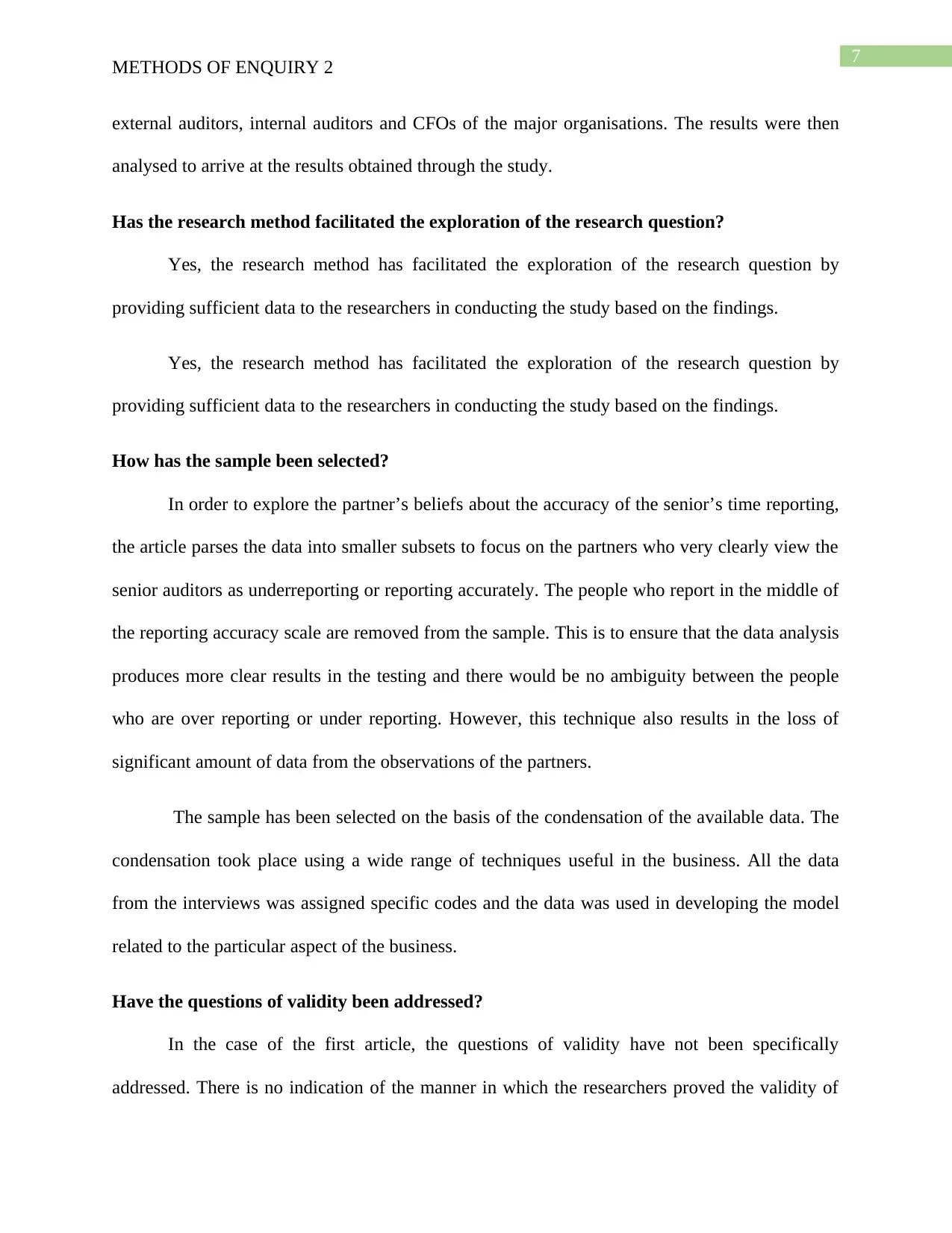
7
METHODS OF ENQUIRY 2
external auditors, internal auditors and CFOs of the major organisations. The results were then
analysed to arrive at the results obtained through the study.
Has the research method facilitated the exploration of the research question?
Yes, the research method has facilitated the exploration of the research question by
providing sufficient data to the researchers in conducting the study based on the findings.
Yes, the research method has facilitated the exploration of the research question by
providing sufficient data to the researchers in conducting the study based on the findings.
How has the sample been selected?
In order to explore the partner’s beliefs about the accuracy of the senior’s time reporting,
the article parses the data into smaller subsets to focus on the partners who very clearly view the
senior auditors as underreporting or reporting accurately. The people who report in the middle of
the reporting accuracy scale are removed from the sample. This is to ensure that the data analysis
produces more clear results in the testing and there would be no ambiguity between the people
who are over reporting or under reporting. However, this technique also results in the loss of
significant amount of data from the observations of the partners.
The sample has been selected on the basis of the condensation of the available data. The
condensation took place using a wide range of techniques useful in the business. All the data
from the interviews was assigned specific codes and the data was used in developing the model
related to the particular aspect of the business.
Have the questions of validity been addressed?
In the case of the first article, the questions of validity have not been specifically
addressed. There is no indication of the manner in which the researchers proved the validity of
METHODS OF ENQUIRY 2
external auditors, internal auditors and CFOs of the major organisations. The results were then
analysed to arrive at the results obtained through the study.
Has the research method facilitated the exploration of the research question?
Yes, the research method has facilitated the exploration of the research question by
providing sufficient data to the researchers in conducting the study based on the findings.
Yes, the research method has facilitated the exploration of the research question by
providing sufficient data to the researchers in conducting the study based on the findings.
How has the sample been selected?
In order to explore the partner’s beliefs about the accuracy of the senior’s time reporting,
the article parses the data into smaller subsets to focus on the partners who very clearly view the
senior auditors as underreporting or reporting accurately. The people who report in the middle of
the reporting accuracy scale are removed from the sample. This is to ensure that the data analysis
produces more clear results in the testing and there would be no ambiguity between the people
who are over reporting or under reporting. However, this technique also results in the loss of
significant amount of data from the observations of the partners.
The sample has been selected on the basis of the condensation of the available data. The
condensation took place using a wide range of techniques useful in the business. All the data
from the interviews was assigned specific codes and the data was used in developing the model
related to the particular aspect of the business.
Have the questions of validity been addressed?
In the case of the first article, the questions of validity have not been specifically
addressed. There is no indication of the manner in which the researchers proved the validity of
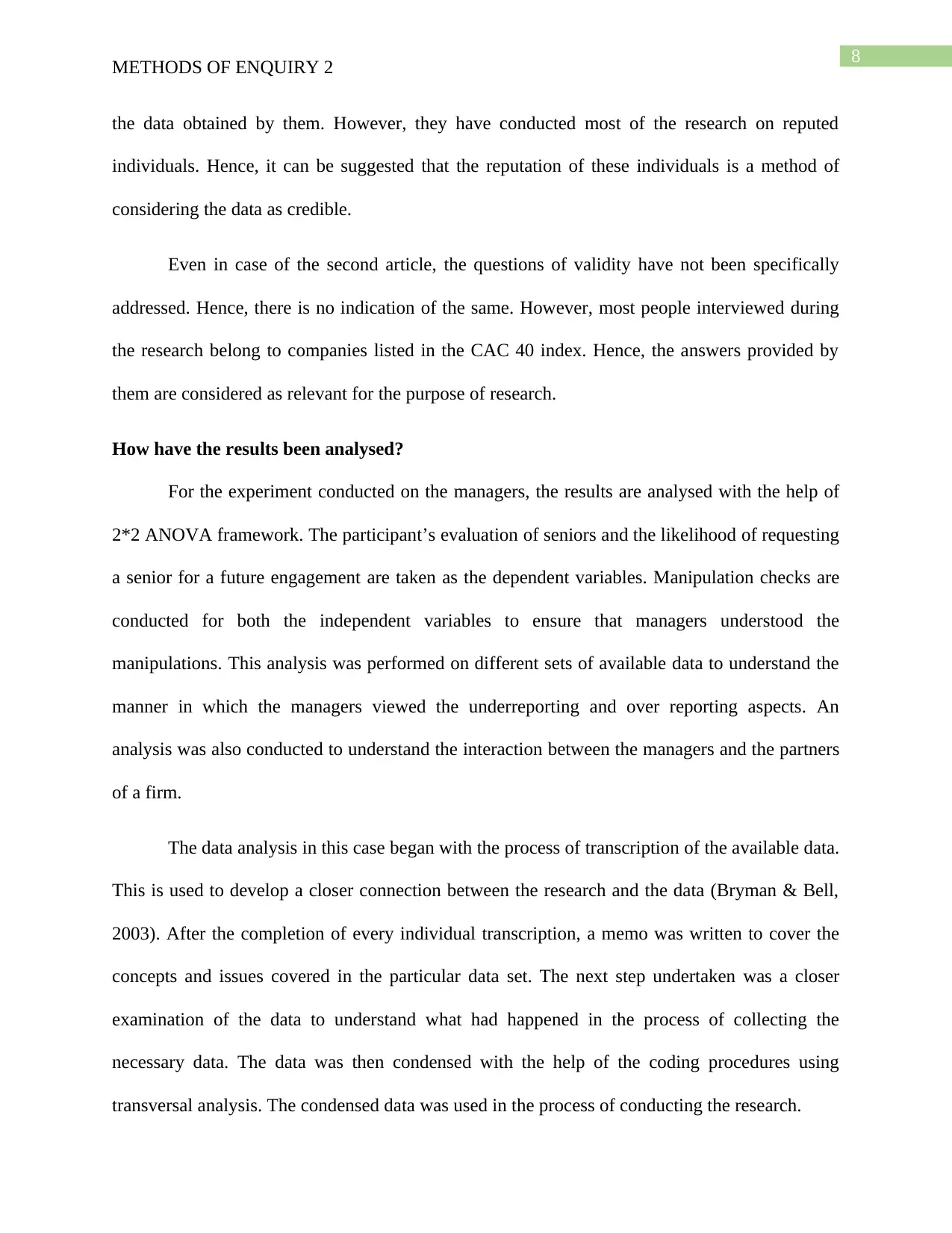
8
METHODS OF ENQUIRY 2
the data obtained by them. However, they have conducted most of the research on reputed
individuals. Hence, it can be suggested that the reputation of these individuals is a method of
considering the data as credible.
Even in case of the second article, the questions of validity have not been specifically
addressed. Hence, there is no indication of the same. However, most people interviewed during
the research belong to companies listed in the CAC 40 index. Hence, the answers provided by
them are considered as relevant for the purpose of research.
How have the results been analysed?
For the experiment conducted on the managers, the results are analysed with the help of
2*2 ANOVA framework. The participant’s evaluation of seniors and the likelihood of requesting
a senior for a future engagement are taken as the dependent variables. Manipulation checks are
conducted for both the independent variables to ensure that managers understood the
manipulations. This analysis was performed on different sets of available data to understand the
manner in which the managers viewed the underreporting and over reporting aspects. An
analysis was also conducted to understand the interaction between the managers and the partners
of a firm.
The data analysis in this case began with the process of transcription of the available data.
This is used to develop a closer connection between the research and the data (Bryman & Bell,
2003). After the completion of every individual transcription, a memo was written to cover the
concepts and issues covered in the particular data set. The next step undertaken was a closer
examination of the data to understand what had happened in the process of collecting the
necessary data. The data was then condensed with the help of the coding procedures using
transversal analysis. The condensed data was used in the process of conducting the research.
METHODS OF ENQUIRY 2
the data obtained by them. However, they have conducted most of the research on reputed
individuals. Hence, it can be suggested that the reputation of these individuals is a method of
considering the data as credible.
Even in case of the second article, the questions of validity have not been specifically
addressed. Hence, there is no indication of the same. However, most people interviewed during
the research belong to companies listed in the CAC 40 index. Hence, the answers provided by
them are considered as relevant for the purpose of research.
How have the results been analysed?
For the experiment conducted on the managers, the results are analysed with the help of
2*2 ANOVA framework. The participant’s evaluation of seniors and the likelihood of requesting
a senior for a future engagement are taken as the dependent variables. Manipulation checks are
conducted for both the independent variables to ensure that managers understood the
manipulations. This analysis was performed on different sets of available data to understand the
manner in which the managers viewed the underreporting and over reporting aspects. An
analysis was also conducted to understand the interaction between the managers and the partners
of a firm.
The data analysis in this case began with the process of transcription of the available data.
This is used to develop a closer connection between the research and the data (Bryman & Bell,
2003). After the completion of every individual transcription, a memo was written to cover the
concepts and issues covered in the particular data set. The next step undertaken was a closer
examination of the data to understand what had happened in the process of collecting the
necessary data. The data was then condensed with the help of the coding procedures using
transversal analysis. The condensed data was used in the process of conducting the research.
⊘ This is a preview!⊘
Do you want full access?
Subscribe today to unlock all pages.

Trusted by 1+ million students worldwide
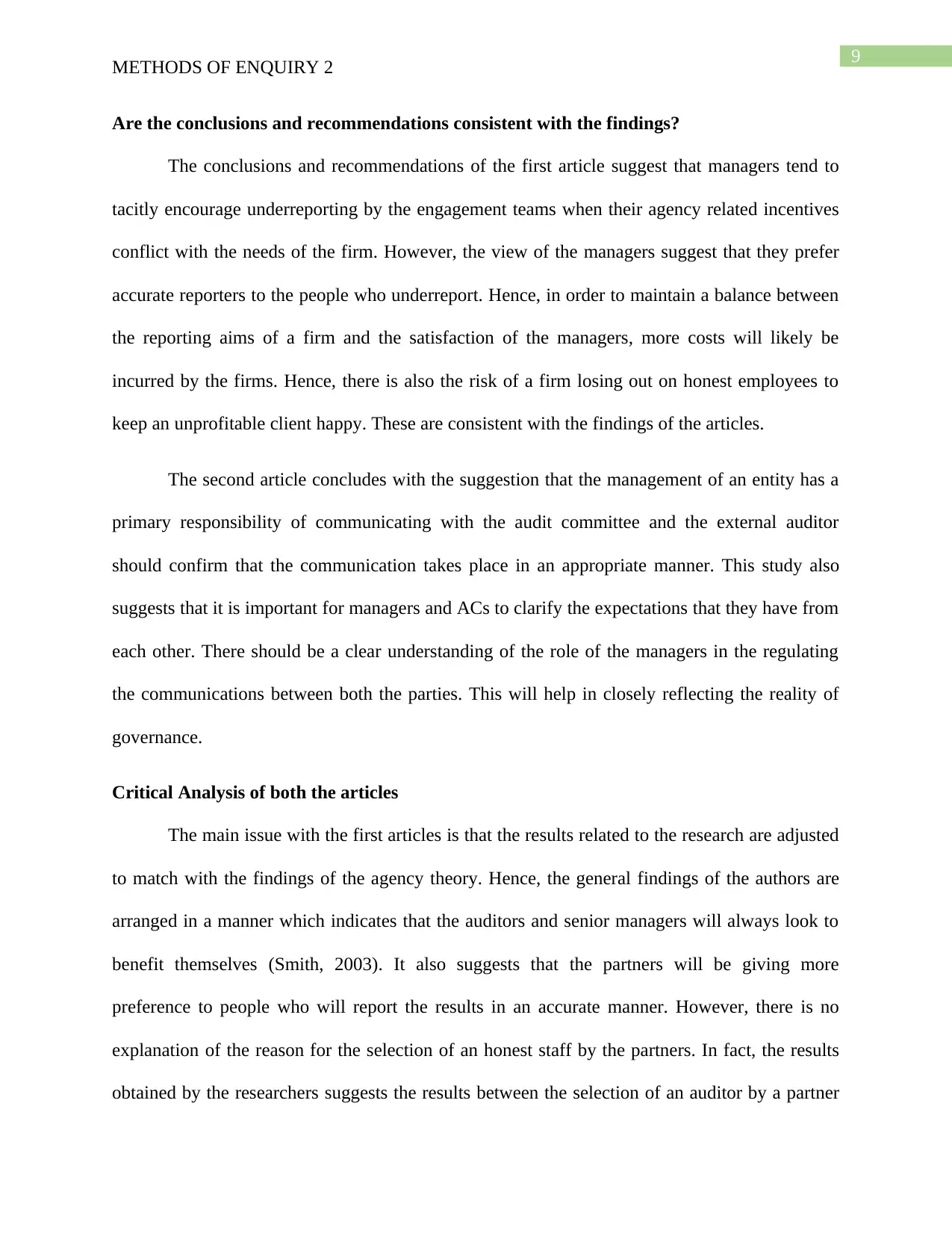
9
METHODS OF ENQUIRY 2
Are the conclusions and recommendations consistent with the findings?
The conclusions and recommendations of the first article suggest that managers tend to
tacitly encourage underreporting by the engagement teams when their agency related incentives
conflict with the needs of the firm. However, the view of the managers suggest that they prefer
accurate reporters to the people who underreport. Hence, in order to maintain a balance between
the reporting aims of a firm and the satisfaction of the managers, more costs will likely be
incurred by the firms. Hence, there is also the risk of a firm losing out on honest employees to
keep an unprofitable client happy. These are consistent with the findings of the articles.
The second article concludes with the suggestion that the management of an entity has a
primary responsibility of communicating with the audit committee and the external auditor
should confirm that the communication takes place in an appropriate manner. This study also
suggests that it is important for managers and ACs to clarify the expectations that they have from
each other. There should be a clear understanding of the role of the managers in the regulating
the communications between both the parties. This will help in closely reflecting the reality of
governance.
Critical Analysis of both the articles
The main issue with the first articles is that the results related to the research are adjusted
to match with the findings of the agency theory. Hence, the general findings of the authors are
arranged in a manner which indicates that the auditors and senior managers will always look to
benefit themselves (Smith, 2003). It also suggests that the partners will be giving more
preference to people who will report the results in an accurate manner. However, there is no
explanation of the reason for the selection of an honest staff by the partners. In fact, the results
obtained by the researchers suggests the results between the selection of an auditor by a partner
METHODS OF ENQUIRY 2
Are the conclusions and recommendations consistent with the findings?
The conclusions and recommendations of the first article suggest that managers tend to
tacitly encourage underreporting by the engagement teams when their agency related incentives
conflict with the needs of the firm. However, the view of the managers suggest that they prefer
accurate reporters to the people who underreport. Hence, in order to maintain a balance between
the reporting aims of a firm and the satisfaction of the managers, more costs will likely be
incurred by the firms. Hence, there is also the risk of a firm losing out on honest employees to
keep an unprofitable client happy. These are consistent with the findings of the articles.
The second article concludes with the suggestion that the management of an entity has a
primary responsibility of communicating with the audit committee and the external auditor
should confirm that the communication takes place in an appropriate manner. This study also
suggests that it is important for managers and ACs to clarify the expectations that they have from
each other. There should be a clear understanding of the role of the managers in the regulating
the communications between both the parties. This will help in closely reflecting the reality of
governance.
Critical Analysis of both the articles
The main issue with the first articles is that the results related to the research are adjusted
to match with the findings of the agency theory. Hence, the general findings of the authors are
arranged in a manner which indicates that the auditors and senior managers will always look to
benefit themselves (Smith, 2003). It also suggests that the partners will be giving more
preference to people who will report the results in an accurate manner. However, there is no
explanation of the reason for the selection of an honest staff by the partners. In fact, the results
obtained by the researchers suggests the results between the selection of an auditor by a partner
Paraphrase This Document
Need a fresh take? Get an instant paraphrase of this document with our AI Paraphraser
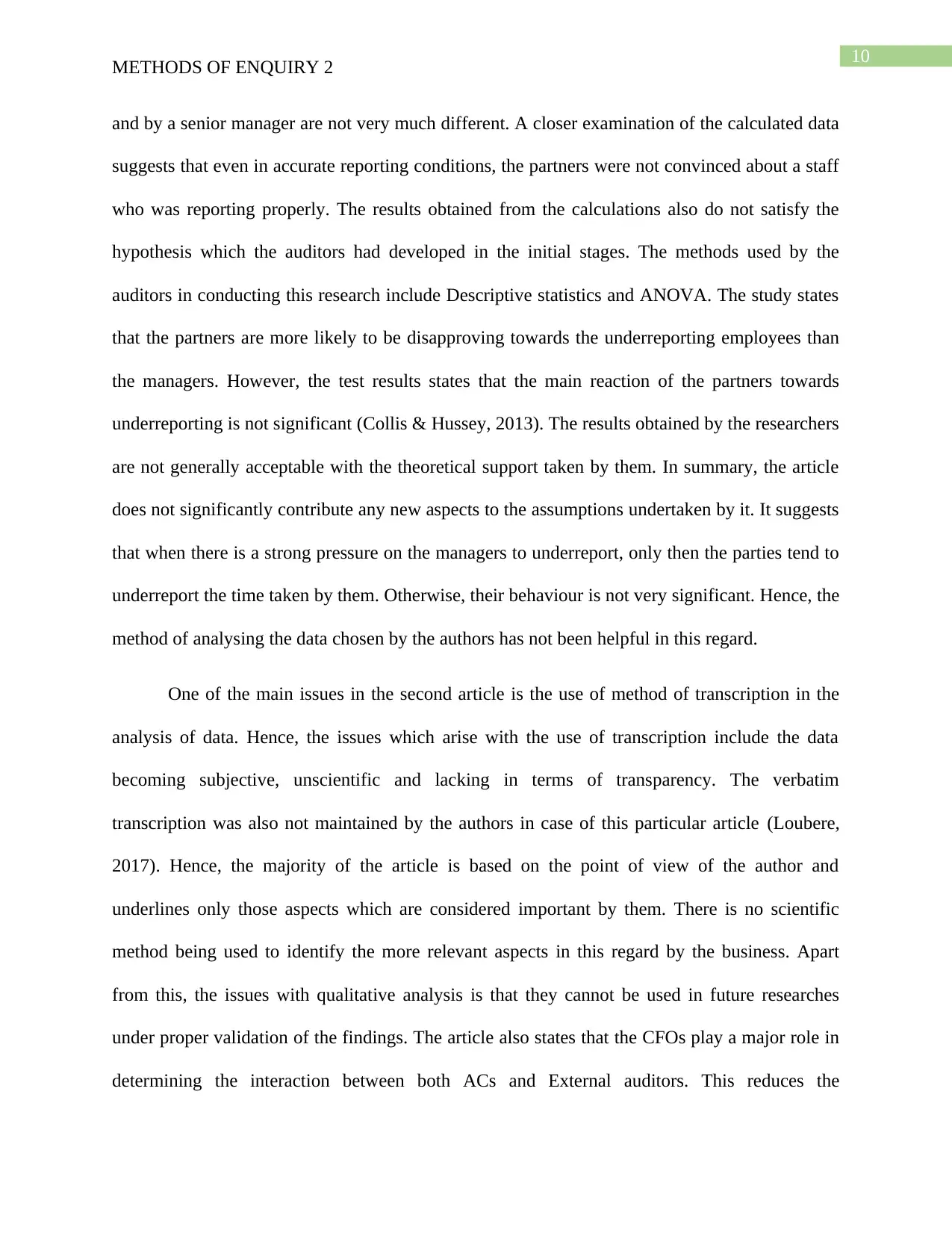
10
METHODS OF ENQUIRY 2
and by a senior manager are not very much different. A closer examination of the calculated data
suggests that even in accurate reporting conditions, the partners were not convinced about a staff
who was reporting properly. The results obtained from the calculations also do not satisfy the
hypothesis which the auditors had developed in the initial stages. The methods used by the
auditors in conducting this research include Descriptive statistics and ANOVA. The study states
that the partners are more likely to be disapproving towards the underreporting employees than
the managers. However, the test results states that the main reaction of the partners towards
underreporting is not significant (Collis & Hussey, 2013). The results obtained by the researchers
are not generally acceptable with the theoretical support taken by them. In summary, the article
does not significantly contribute any new aspects to the assumptions undertaken by it. It suggests
that when there is a strong pressure on the managers to underreport, only then the parties tend to
underreport the time taken by them. Otherwise, their behaviour is not very significant. Hence, the
method of analysing the data chosen by the authors has not been helpful in this regard.
One of the main issues in the second article is the use of method of transcription in the
analysis of data. Hence, the issues which arise with the use of transcription include the data
becoming subjective, unscientific and lacking in terms of transparency. The verbatim
transcription was also not maintained by the authors in case of this particular article (Loubere,
2017). Hence, the majority of the article is based on the point of view of the author and
underlines only those aspects which are considered important by them. There is no scientific
method being used to identify the more relevant aspects in this regard by the business. Apart
from this, the issues with qualitative analysis is that they cannot be used in future researches
under proper validation of the findings. The article also states that the CFOs play a major role in
determining the interaction between both ACs and External auditors. This reduces the
METHODS OF ENQUIRY 2
and by a senior manager are not very much different. A closer examination of the calculated data
suggests that even in accurate reporting conditions, the partners were not convinced about a staff
who was reporting properly. The results obtained from the calculations also do not satisfy the
hypothesis which the auditors had developed in the initial stages. The methods used by the
auditors in conducting this research include Descriptive statistics and ANOVA. The study states
that the partners are more likely to be disapproving towards the underreporting employees than
the managers. However, the test results states that the main reaction of the partners towards
underreporting is not significant (Collis & Hussey, 2013). The results obtained by the researchers
are not generally acceptable with the theoretical support taken by them. In summary, the article
does not significantly contribute any new aspects to the assumptions undertaken by it. It suggests
that when there is a strong pressure on the managers to underreport, only then the parties tend to
underreport the time taken by them. Otherwise, their behaviour is not very significant. Hence, the
method of analysing the data chosen by the authors has not been helpful in this regard.
One of the main issues in the second article is the use of method of transcription in the
analysis of data. Hence, the issues which arise with the use of transcription include the data
becoming subjective, unscientific and lacking in terms of transparency. The verbatim
transcription was also not maintained by the authors in case of this particular article (Loubere,
2017). Hence, the majority of the article is based on the point of view of the author and
underlines only those aspects which are considered important by them. There is no scientific
method being used to identify the more relevant aspects in this regard by the business. Apart
from this, the issues with qualitative analysis is that they cannot be used in future researches
under proper validation of the findings. The article also states that the CFOs play a major role in
determining the interaction between both ACs and External auditors. This reduces the
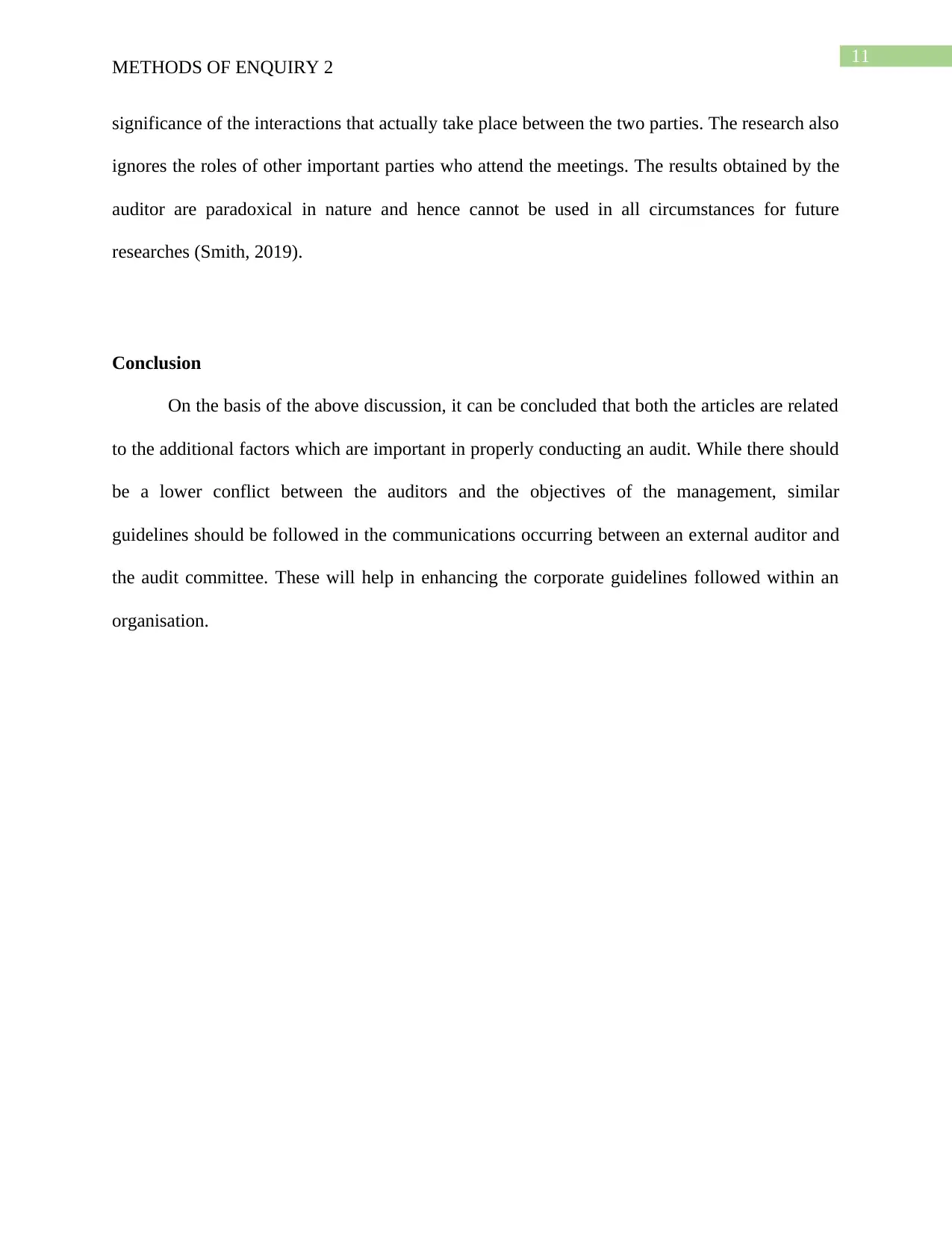
11
METHODS OF ENQUIRY 2
significance of the interactions that actually take place between the two parties. The research also
ignores the roles of other important parties who attend the meetings. The results obtained by the
auditor are paradoxical in nature and hence cannot be used in all circumstances for future
researches (Smith, 2019).
Conclusion
On the basis of the above discussion, it can be concluded that both the articles are related
to the additional factors which are important in properly conducting an audit. While there should
be a lower conflict between the auditors and the objectives of the management, similar
guidelines should be followed in the communications occurring between an external auditor and
the audit committee. These will help in enhancing the corporate guidelines followed within an
organisation.
METHODS OF ENQUIRY 2
significance of the interactions that actually take place between the two parties. The research also
ignores the roles of other important parties who attend the meetings. The results obtained by the
auditor are paradoxical in nature and hence cannot be used in all circumstances for future
researches (Smith, 2019).
Conclusion
On the basis of the above discussion, it can be concluded that both the articles are related
to the additional factors which are important in properly conducting an audit. While there should
be a lower conflict between the auditors and the objectives of the management, similar
guidelines should be followed in the communications occurring between an external auditor and
the audit committee. These will help in enhancing the corporate guidelines followed within an
organisation.
⊘ This is a preview!⊘
Do you want full access?
Subscribe today to unlock all pages.

Trusted by 1+ million students worldwide
1 out of 13
Related Documents
Your All-in-One AI-Powered Toolkit for Academic Success.
+13062052269
info@desklib.com
Available 24*7 on WhatsApp / Email
![[object Object]](/_next/static/media/star-bottom.7253800d.svg)
Unlock your academic potential
Copyright © 2020–2025 A2Z Services. All Rights Reserved. Developed and managed by ZUCOL.





